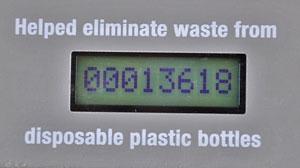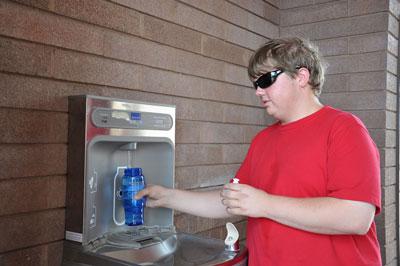Editor's note: Due to concerns from the Haws Corporation, which has trademarked the phrase "Hydration Station," this story has been edited to remove those two words as they appear back to back.
A new water-filling station at the main visitor center for Lake Mead National Recreation Area has been in service for six months, and in addition to reducing the use of disposable plastic water bottles, use of the filtered water is proving popular with visitors. Since it's installation, the station has been used to fill 13,600 water bottles.
You'd expect to find a drinking fountain at any park visitor center'especially one in the desert'and this filling station does that job nicely, plus a little more. It works just like a standard drinking fountain but also has a shelf for easy filling of water bottles. A sensor initiates the water fill, and every time a bottle is filled, that action is automatically counted and displayed on the station.
'Word is getting around that this is the place to stop and refill your water bottle, which with the heat and everything else, that's a really good message to have,' said Michelle Riter, a Lake Mead NRA district interpreter.
Riter said installation of the water-filling station at the Alan Bible Visitor Center is part of the Lake Mead NRA's Climate Friendly Parks action plan to cut down on plastic water bottle waste. This plan includes initiatives to increase visitor use of refillable water bottles, increase number of filling stations in the park and collaborate with the visitor center store to sell less expensive refillable water bottles.
Once the water-refilling station was installed, Riter said they stopped selling bottled water at the visitor center store and began selling more varieties of refillable water bottles. She said the least expensive water bottle is only $2.99 and has the Lake Mead NRA logo on it along with facts about the park.
The Vanlue family, from O'Fallon, Mo., visited the store in early August, purchased a refillable water bottle and filled it at the station. After Jacob, 17, filled up his bottle, his mom, Barbara, said she was thankful for the station and the reduction of plastic water bottle waste in landfills.

A counter automatically records how many times the water bottle portion of the station has been used. NPS photo.
It's not just popular with families and individual visitors. Gabriel Kelsey-Yoder, Western National Parks Association (WNPA) bookstore manager, said large tour groups often stop by the visitor center and have been receptive to purchasing and using the refillable water bottles. She said she has seen campground users come to refill their water bottles at the refilling station as well because they prefer the cold, filtered water.
Park visitors, especially local hikers and bicyclists who use the trails, have been spreading the news about the new refilling station by word of mouth and through social media, Riter added. They are excited to see how many water bottles have been refilled and want refilling stations to be installed in other areas of the park.
Funding for the refilling station was provided by the WNPA. The Alan Bible Visitor Center is located just of US 93 between Boulder City, Nevada, and Hoover Dam.




Comments
Thanks for the research, Lee! It is surprising how much this type of fixture costs. I wonder how long they last, and if the existing drinking fountains were worn out, and how often NPS press releases include cost details, or if Kurt usually edits that out?
Good point about offsetting the litter costs, dahkota.
Actually, ec, those folks who are dumb enough to drive without a safety belt or ride a motorcycle without a helmet are costing the rest of us. States that don't have belt or helmet laws have much higher insurance premiums for all drivers. If you live in a city without smoke detector laws, your home insurance premiums are higher. You say you don't want to force inconvenience on others, but apparently you're okay with letting them force extra costs on the rest of us.
Now, bottle deposit? Yes, yes, and yes. But the retail store lobbies have convinced our legislators that it's a bad idea and in Utah, at least, "recycling" is a dirty word on Capitol Hill because implementing it would cost some money or be an "inconvenience." (That word has been used in committee hearings on the subject many times.)
If we are going to try to look at cost/benefit, we need to be sure we are looking at all the variables and not just a select few.
Could you document that?
Here, I will help - New Hampshire is the only state without a seatbelt law. It has the fourth lowest auto insurance rates in the country.
http://www.insure.com/car-insurance/car-insurance-rates.html
My insurance company asks if I have a smoke detector and adjusts my rate accordingly. I certainly am not paying for the lack of a smoke detector in someone elses home.
Of course this is off topic - but it demonstrates how you just make things up.
That would be relevant if the retail store lobbies set NP policy. The NPs could place a deposit requirement on their sales without the involvement of the retail store lobbies or our legislators.
"And so what if a bottle "didn't make it to a land fill"? Why do we have to "start somewhere"?!"
Hey gang! Since it mindlessly doesn't matter, EC volunteered to have everyone dump their empty plastic bottles in his back yard!
re: "Maybe the NPS is not quite as underfunded as they like to claim?" and "Not to mention the loss of revenue to the Park System by not selling bottled water."
It's important to note that this station was not funded by the NPS, but by the partner organization that also runs the bookstore. So, it didn't cost the NPS – or the taxpayers—a dime in either purchase of the station or lost revenue. As a result, it's hard to see why some folks are so negative about it.
An earlier comment claimed a "regular" water fountain would serve the same purpose, but not quite true. It's only possible to fill most water bottles part-way due to the angle you have to tip the bottle to fill it at a regular fountain. Not a big deal, but it's nice to leave with a full bottle before you head out into the heat at Lake Mead. So, this model is a nice convenience, at no cost to the taxpayer.
I don't know about the tradeoff in lost revenue from throw-away water bottles vs. gained revenue from sales of reusable water bottles by the bookstore, but there is at least some offset.
The discussion, as have previous ones on related topics, boils down to two different mindsets. Some believe even small steps to encourage people to switch to and use reusable water bottles are worthwhile not just for the short-term savings but because that may also encourage them to consider other ways of conserving resources.
The other group believes it's a waste of time and money to encourage people to conserve resources, whether it be landfill space, or the plastic water bottles themselves, or the raw materials and energy to make them, or anything else. After all, we have all we need today, so why bother?
That group is pretty well summed up by the comment: "And so what if a bottle "didn't make it to a land fill"? Why do we have to "start somewhere"?
How is banning the sale of bottled water not lost revenue?
Yes this is the group that doesn't succumb to every "chicken little the world is coming to an end" disaster story. This is the group that believes it is better to grow the pie than to make sure it is divided equally. This is the group that has faith in the ingenuity of man to expand his horizons. This is the group that understands things like fertilizers and genetic engineering can expose "the world will run out of food" as the poppy cock it is or that advanced drilling techniques can make fools of those that predicted "peak oil" would occur decades ago. These are the folks that want to address real problems with effective solutions not to chase windmills with "feel good" actions that have no real impact.
Nice post Jim Burnett, I think it makes a great gesture to have a place to refill your water bottles, and I think most people like the idea. I can tell you I just came off a Wildland Fire that maintained a camp for over 2000 firefighters for 14 days before we started winding down (containment of the fire), its hard to believe how many cases of water bottles ended up in the dumpsters. When I first started in Fire in 1960, we had canteens, well, times change. In any case I do agree with ecbuck on the issue of the need to institute a deposit, boy does that make a difference in the litter issue.
Thanks for pointing out my mistake about the funding source, Jim. Probably a senior moment; somehow, the next to last sentence just didn't register.
I know what you mean about clearance for filling water bottles. I was envisioning just adding a spigot on the line to the existing water fountain, but as I said, probably wouldn't save that much and might be too low or too high to satisfy ADA, some vandal would probably leave it on, etc. NPS restroom sinks used to be deep enough for bottle filling; I suppose they're trending towards shallow to discourage dishwashing (or worse).
Just for the record, I recycle as religiously as some might believe NPS press releases. I've never bought bottled water in my life. I strongly approve of conserving resources, most especially tax dollars. I just don't see much evidence the development faction in the parks feels that way.
And no offense, ec, but we differ on AGW and whether either political party would be any better at ending the pork barrel system. A pox on both their houses! Isn't money just a convenient symbol for resources, which are finite on this planet? I'm not so sure that pie can be grown much larger without further threatening our spaceship's life support systems. I suspect we are all lucky to live pretty close to 'peak pie'.